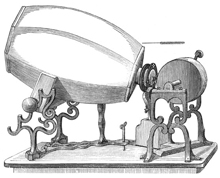|
|
More on these and future activities is available on the |
|

|
|
Today
7 a.m. to 3 p.m.
Philanthropy Club
Blood Drive
Bldg. 2-100B
10 a.m. to 2 p.m.
OCFO/Sponsored Projects
eBuy Kick-Off Event-Vacuum Products
Bldg. 6 Lobby
Noon
Environmental Energy Technologies
Japan's Energy Efficiency Policy And The Top Runner Program
Takeshi Miki
Bldg. 90-3122
Noon
Yoga Club
Class with Naomi Hartwig
Bldg. 70-191
Noon
Dance Club
Practice Session
Bldg. 51 Lobby
2 p.m.
EHS 10
Introduction to EH&S at Berkeley Lab
Bldg. 70A-3377
4 p.m.
Advanced Light Source
Some Recent Hard X-ray Photoemission Studies at SPring8
Keisuke Kobayashi
Bldg. 2-100B
Monday
Noon
Yoga Club
Class with Inna Belogolovsky
Bldg. 70-191
Noon
Dance Club
Pot-Luck Dance Party
Bldg. 51 Lobby
4:30 p.m.
Physics Department
The ATA-42: Life, the Universe, and a Wide-Angle, Panchromatic Radio Camera for SETI and Radio Astronomy
Jill Tarter
1 LeConte
|
|
|
 |
|
| |
This week's menu
Breakfast
6:30 to 10:30 a.m.
Lunch
11 a.m. to 3 p.m.
Coffee Bar
Mon. - Thur: 6:30 a.m. - 6 p.m.
Friday: 6:30 a.m. - 5 p.m.
Weekends: 8:30 a.m. to 2:30 p.m. |
| |
|
|
|
 |
|
 |

|
 |
|
A 19th century phonautograph |
|
Lab Scientists Help
Play Earliest Recording
Berkeley Lab’s Earl Cornell and Carl Haber helped a group of audio historians play a sound recording that predates Edison’s invention of the phonograph by 17 years. The historians recently discovered the recording of a person singing “Au Clair de la Lune” in Paris. It was made in 1860 on a phonautograph, which was designed to record sounds visually, not to reproduce them. The recording was converted from squiggles on paper to a digital audio file using technology developed at Berkeley Lab. The research was featured in yesterday's New York Times, as well as in a segment on NPR's All Things Considered.

State Taking a Second
Look at Nuclear Power
As concerns about greenhouse gases and global warming mount, nuclear energy is getting a second look in California, with supporters ranging from the governor to at least one environmental activist. But some feel nuclear is too big, too expensive, and too risky from a financial perspective. "The big issue is construction costs for new plants," said Per Peterson, with Berkeley Lab’s Accelerator and Fusion Research Division and nuclear energy advocate. Full story.

|
 |
|
 |
 |

Extinction May be Due
To Meteorite Impact
Berkeley Lab nuclear scientist Richard Firestone was part of a team that in 2005 reported evidence of a possible comet that could have caused a mass extinction of many of the large mammals in North America, including mammoths, around 13,000 years ago. The team now theorizes that a meteorite may have caused a similar type of extinction in parts of Alaska and Siberia around 35,000 years ago. The Sithylemenkat Lake in Alaska was probably created by an asteroid big enough to cause regional destruction, "kind of like you walked into machine gun fire, except that the bullets hit all at once," says Firestone. Full story.

Filling Up a Breeze
For Danish Drivers
A Danish utility recently announced a system to charge electric cars. For Denmark, it is a creative way to deal with surpluses of wind power. Consumers will be able to charge electric car batteries at windy times when power is cheap. Unlike Europe, U.S. electricity grids are fragmented and out of date, making moving power around difficult. And windy areas are often located far from centers where lots of power is needed. "The grid here just isn't as strong, in part because the country isn't as densely packed," said Ryan Wiser, with Berkeley Lab’s Environmental Energy Technologies Division. "But studies have shown that the grid, with modest tweaks, is up to the task." Full story.

|
 |
|
 |
Affirmative Action
And EEO Policy
The Laboratory will not engage in discriminatory practices against any person employed or seeking employment because of race, color, religion, marital status, national origin, ancestry, sex, sexual orientation, gender identity, pregnancy (including pregnancy childbirth, and medical conditions related to pregnancy or childbirth), physical or mental disability, medical condition (cancer related or genetic characteristics), age, citizenship, or status as a covered veteran, special disabled veteran, Vietnam-era veteran, veteran who served on active duty during a war or in a campaign or expedition for which a campaign badge has been authorized, or any veteran during the one-year period that begins on the date of such veteran's discharge or release from active duty. Go here for more information.

|
 |
|
|
 |
|
|
|
|
|
|
 EMERGENCY INFO EMERGENCY INFO |
 |
Emergency: Call x7911
Cell Phones: Call 911
Non-emergency Incident Reporting: Call x6999
SECON level 3
More Information |
 |
|
|
 |
|
|

